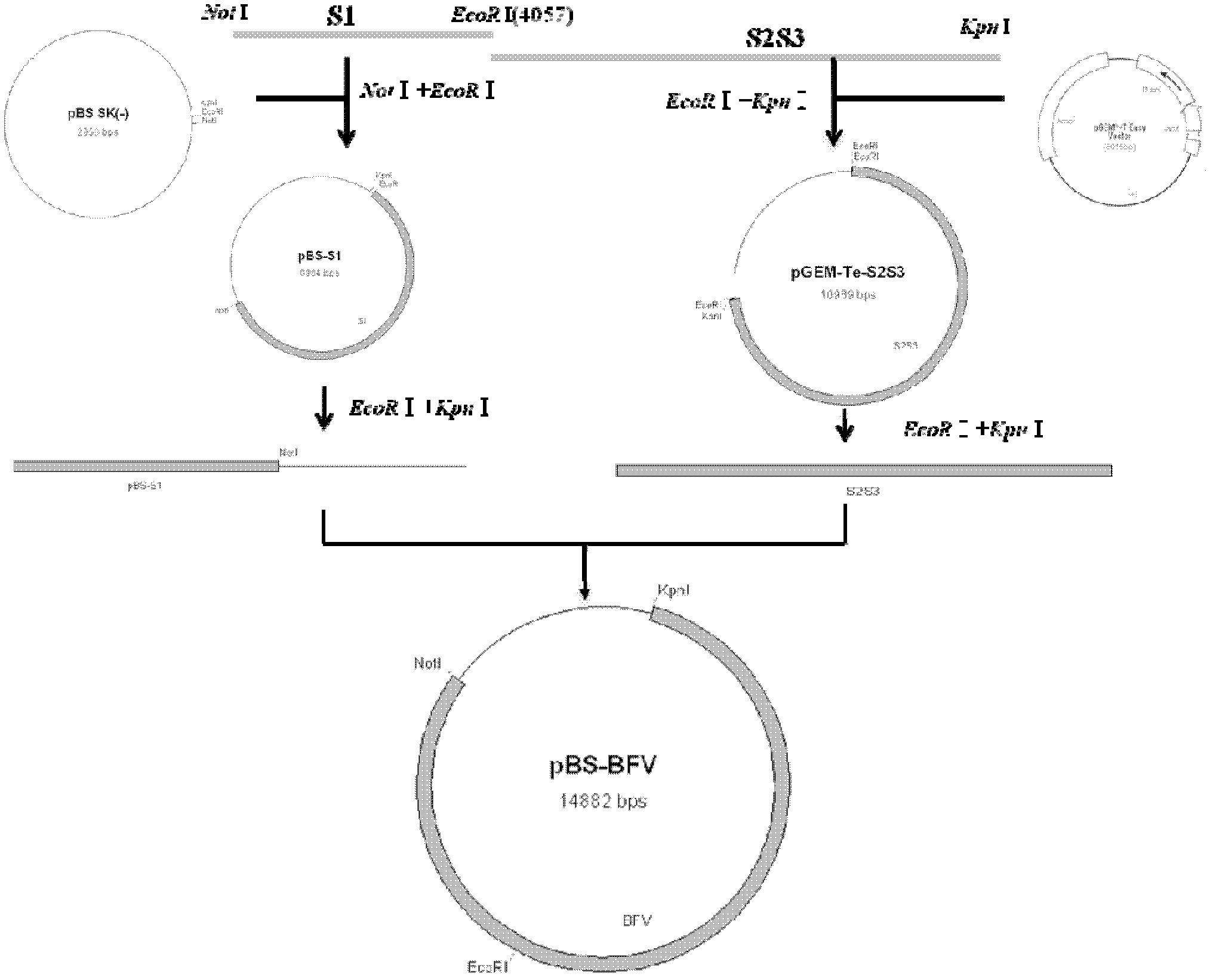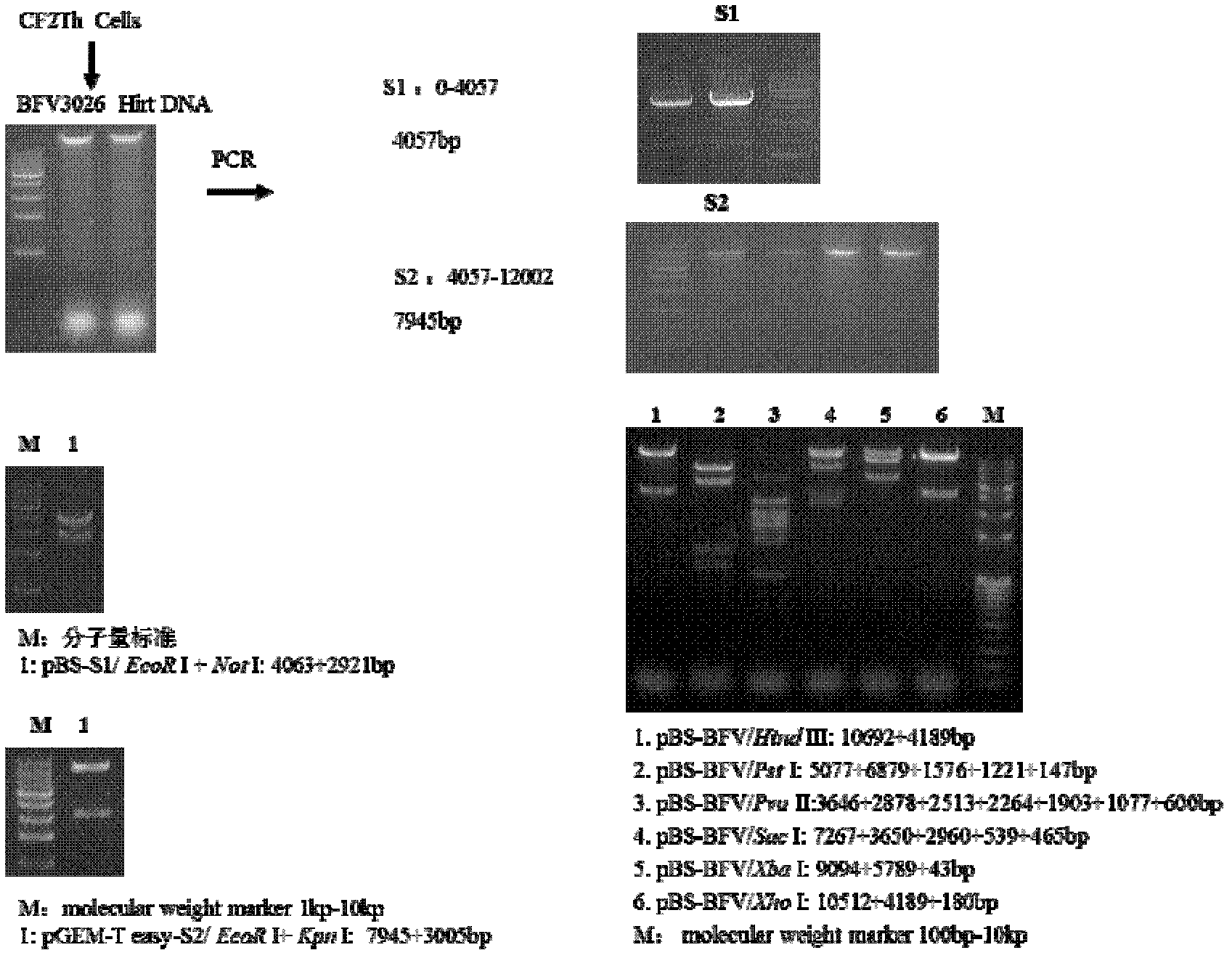Construction and application of infectious clone of bovine foamy virus
A technology for infectious cloning, bovine foamy virus, applied in the direction of microorganism-based method, determination/inspection of microorganisms, introduction of foreign genetic material using vectors, etc., to achieve high safety effects
- Summary
- Abstract
- Description
- Claims
- Application Information
AI Technical Summary
Problems solved by technology
Method used
Image
Examples
Embodiment 1
[0056] Obtaining the genomic cDNA of Chinese bovine foamy virus BFV3026.
[0057] Use the method of extracting Hirt DNA to extract the DNA of the virus that has not integrated into the cell genome and use it as a template for PCR. The specific method is as follows:
[0058] After the retrovirus infects the host cell, the RNA is first reverse-transcribed into double-stranded cDNA, and then integrated into the host genome. During rapid viral replication, large numbers of non-integrated linear or circular cDNA molecules are often present in the nucleus, especially for foamy viruses. When conventional methods extract host genome cDNA, the proportion of viral cDNA is low (<15%), while the method established by Hirt can significantly increase the abundance of viral cDNA in the host cell DNA sample (commonly referred to as Hirt DNA), the highest Up to 80%. In this paper, referring to Hirt's method with some changes (Hirt, 1967; Bieniasz et al, 1995a; Nandi, 1999), high-copy BFV3026...
Embodiment 2
[0077] Construction of infectious full-length clones of BFV3026.
[0078] The purpose is to construct the full-length clone of Chinese bovine foamy virus BFV3026 isolated in our laboratory by molecular cloning. The pBlueScript SK(-) prokaryotic cloning vector was selected, and the BFV3026 genomic cDNA was ligated into it through restriction sites to obtain several strains of full-length BFV3026 clone pBFV. Specific operations include: purification of PCR products, cloning of PCR products, screening and identification of BFV3026 genome cDNA fragment clones, construction and identification of full-length BFV3026 clone pBFV, and mass preparation of full-length plasmid pBFV.
[0079] First, the purification scheme of PCR products:
[0080] After the PCR product was electrophoresed on a 1% agarose gel by mass percentage, it was purified and recovered using a QIAGEN gel recovery kit. Purified PCR samples were stored at -20°C.
[0081]
[0082] PCR(S1) PCR(S2)
[0083]
[0...
Embodiment 3
[0135] The purpose of screening and phenotypic analysis of bovine foamy virus BFV3026 with infectivity in BFVL cells is to detect the virus activity of all constructed full-length BFV3026 clone pBFV. The BFVL cell line was transfected with the pBFV plasmid, the subsequent luciferase activity was analyzed, and clones with trans-transcription activation activity were initially screened.
[0136] First, the transfection of the plasmid.
[0137] 1. Inoculate BFVL cells in a six-well plate at a density of 2×105 / well, add 2ml of DMEM containing 10% fetal bovine serum and 1% penicillin, and culture in a CO2 incubator at 37°C for 18-24h. Start the transfection operation when the cells cover 50% to 80% of the bottom surface of the well;
[0138] 2. Preparation of DNA / PEI Mixture
[0139] 1) Solution A: Dilute 1 μg of the plasmid to be transfected to 70 μl with DMEM without serum and antibiotics (negative control: pBS plasmid;
[0140] 2) Take 4 μL of PEI (1 mg / Ml, Polysciences, Inc....
PUM
 Login to View More
Login to View More Abstract
Description
Claims
Application Information
 Login to View More
Login to View More - R&D
- Intellectual Property
- Life Sciences
- Materials
- Tech Scout
- Unparalleled Data Quality
- Higher Quality Content
- 60% Fewer Hallucinations
Browse by: Latest US Patents, China's latest patents, Technical Efficacy Thesaurus, Application Domain, Technology Topic, Popular Technical Reports.
© 2025 PatSnap. All rights reserved.Legal|Privacy policy|Modern Slavery Act Transparency Statement|Sitemap|About US| Contact US: help@patsnap.com



